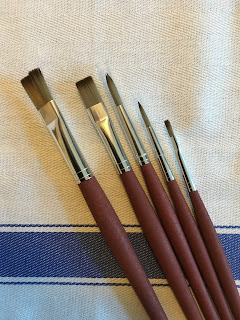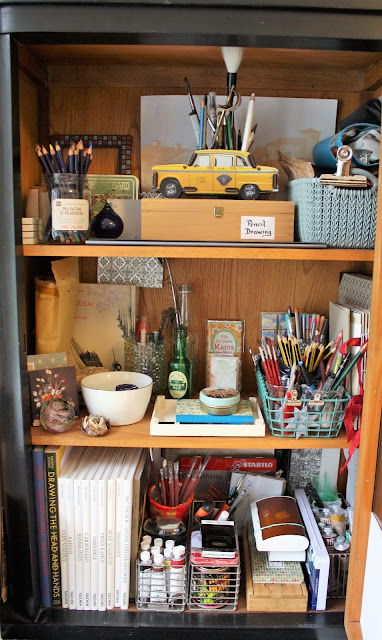Choosing the right paintbrushes- 7 different mediums and their brushes
When I started painting 13 years ago I went to our local hardware store and bought myself a package of about five mixed brushes ranging from small and round to wide and flat. The whole package cost under five euros and I felt like I had spent a reasonable amount on this necessary but over rated supply. These brushes carried me through at least my first 20 paintings- I fought with them while trying to create straight lines, blend colours for water, and add detail. I used them to lay in large areas of snow on mountains and blend clouds. And bit by bit the bristles broke off, the handles became splotched with colour and they acquired that glamourous 'art studio' look. The patina of the studio. Each one told a story, or perhaps 20 stories. Each was a known and trusted friend, each a wrestling opponent.
In the first few years, with only a book and a lot of my own photos to guide me, I was unaware that the brushes you use actually make a difference in how you experience the painting process. I assumed that the reason painting was hard was because I was a novice, and not a very good one at that. I am glad now that I had that time to focus only on technique without becoming too wrapped up in an art supply addiction, but I am equally happy that in my first botanical illustration seminar several years ago the teacher pointed out that certain struggles were the result of poor tools rather than lack of ability. I left that seminar with a new interest in brushes. I went directly to the art store and bought several different types and began, brush by brush to fall in love not only with the paint but with the brushes too.
Today, preparing photos for this blog post I began emptying brushes out of my drawing cabinet and studio containers. There, among the sleek new models, sit the ancient hardware store flat brushes, dogeared, encrusted with layers of paint, and still used on almost every single canvas I paint. In fact two of them are in water now, having been used just yesterday to work on the large landscape which eclipses my almost, but not quite, equally substantial easel.
A woman in my urban sketching group suggested paintbrushes as a topic for the blog and I am glad she did. It is a great idea and one I would have enjoyed having an overview of all those years ago. Although knowing me, I would have probably still bought the package from the hardware store.
Paint brushes are generally either round or flat. They can be made of all types of materials from synthetic bristles to squirrel hair. Most of the ones I own are either synthetic or Marten hair (Marderhaarpinsel) paintbrushes. The Marten is a small weasel type animal whose tail hair is ideal for brushes. These are nice to work with. I try to buy synthetic when it is good enough and only a few of the 'real' brushes as I love them but don't want to be consuming huge numbers of animals to satisfy my painting needs. I wear out brushes and having a couple of good ones for fine detail is enough for me.
Almost all of my brushes are da vinci brand since that is what my art store carries. They are a great brand but not the only good one. I will try to link similar brushes below. In this post I will be referring to brushes generally as small or medium, etc... Different artists work in different scales and so when I refer to a small brush it matters less whether that brush is a number 00 or a 6 or 12. It matters that, to you, in your work, it is the smaller of the battery of brushes you find useful. Here are a list of different medium and techniques and the brushes I find most useful.
1. Graphite:
A student grade brush is good enough for this medium. Flat ones are nice for creating shadow and a small round one will be useful in creating detail. The key is too avoid any brushes with bristles that are too slippery as the graphite will simply slide off the brush.
2. Ink:
When using ink I always use a round brush. This can either be a Chinese lettering style brush, a larger round aquarelle brush, or a french aquarelle brush. These form beautiful long sharp tips when dipped into water or liquid ink.
3. Aquarelle (also called watercolor):
Here I use round brushes in varying sizes. Large soft brushes are great for filling in large areas with washes of colour. Small brushes with harder bristles that form a nice point are great for adding layers of detail. I like to have both for any illustration. Sometimes I use the Chinese lettering style brushes for backgrounds and colour blocking since they hold a lot of water.
4. Oil painting:
These brushes tend to be round. Since I like flat ones so well I also own a few flat ones. In a pinch you can use the same type of brushes for acrylic and oil (shhhh... dont tell anyone I said so), but I wouldn't use the same ACTUAL brushes for both. Two sets is a must.
5. Travel brushes/Urban sketching:
Sketching on the go is different from studio painting and can often be accomplished with one or a few simple brushes. The important thing here is to make sure that the tips are protected when the supplies are packed up. I have a set that screw closed as well as a water brush. I like to take the mini ones too. I usually bring the little plastic cap the brush came with for protection. These are primarily used for ink or watercolour in my case and are therefore round. They are also relatively small since my sketchbook and kit is as well. If you find out more about what I take with me when I paint away from the studio check out the links at the bottom of the page.
6. Botanical Illustration:
This is another form of watercolor. The brushes are again round but in this case very small. A small one is used as a mixing brush and the detailing ones are extremely fine. The goal here is to get brushes that use their bunch of bristles to support one central bristle that can be used to paint strokes with the width of a single hair. Trimming the brush is not unusual.
7. Acrylic:
Most of the brushes up until now have been round but here they are primarily flat. There can be other shapes as well such as fans but I tend to stick to flat brushes. I use a wide variety of ages and textures of brushes for acrylics. Fine ones provide beautiful detail where old battered ones create light, fluffy clouds.
- Da Vinci student universal brushes for graphite
- Ink - bamboo brush
- Da Vinci watercolour set
- Da Vinci brushes for oil
- Da Vinci travelbrush
- DaVinci Mini brush
-Urban Sketching Waterbrush
-botanical illustration brush set
-acrylic brushes ( not mine but similar)
- Large flat brushes for acrylics
*Affiliate links- this is not a sponsored post
If you liked this post you might also like:
-Field sketching kit must haves
-Taking and using reference photos
-Sketching kit for the US
- Choosing the right paper






























Comments
Post a Comment